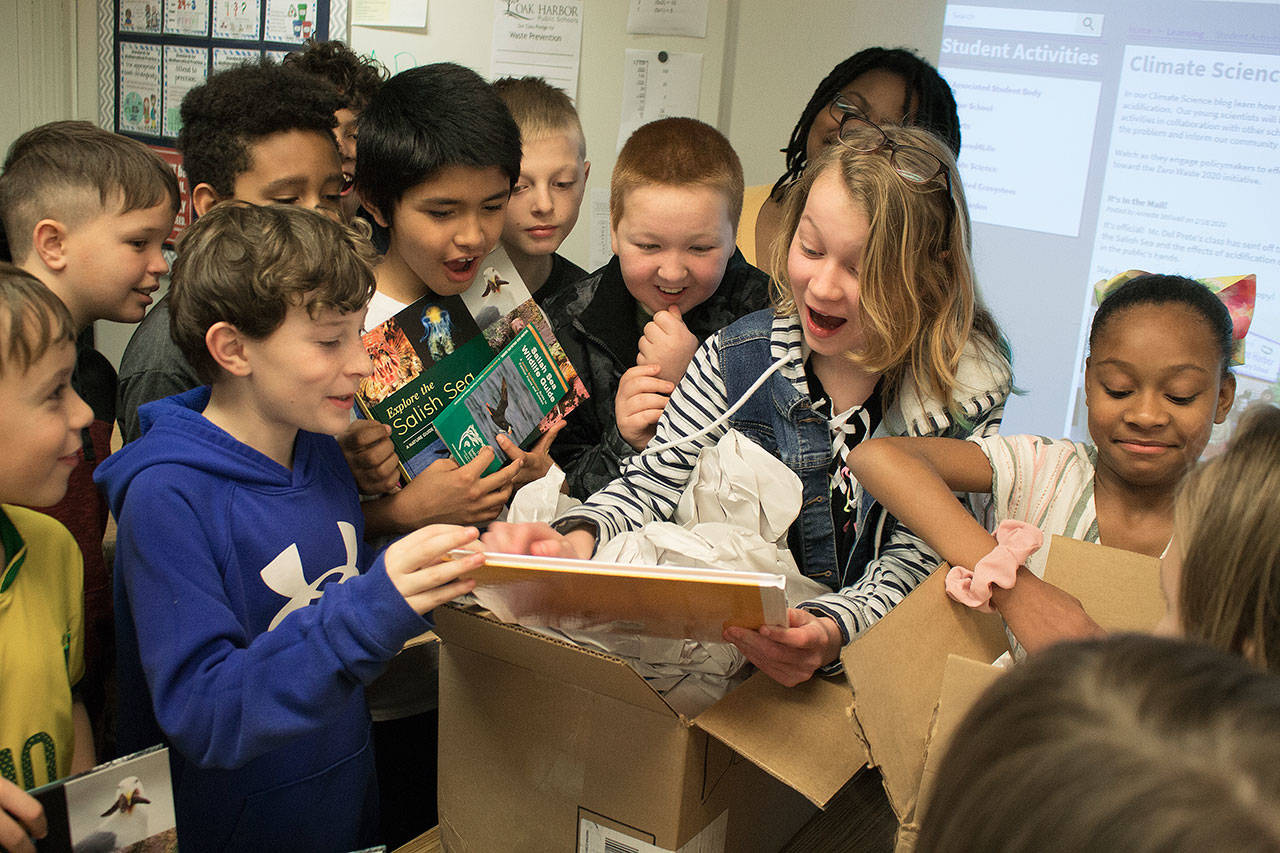John Del Prete’s fourth-grade class crowded around two cardboard boxes stacked on a small cluster of desks near the whiteboard.
The students were electric in anticipation, waiting for Del Prete to give the go-ahead so they could tear into the boxes.
It was like Christmas on March 11, only without the colorful wrapping paper, and everyone already knew what was inside the boxes. Still, the excitement in the Crescent Harbor Elementary classroom resulted in audible gasps and praise as the class opened the boxes and witnessed, for the first time, the product of its year-long endeavor.
Fourth-grader Peyton Bodenhafer, 10, shouted “I made that! I made that!” as she looked down at the cover of the book that the class wrote and illustrated, “Invisible Pollution in the Salish Sea.”
Her artwork, which features a grey seal against a blue ocean, is the gateway to the research and reporting the class did about the effects of carbon dioxide acidification on the Salish Sea, the coastal bioregion that stretches from Olympia to Desolation Sound in Canada.
“I thought that the animal, the seal, would be cute and people would realize ‘oh I want to go into this book because the seal is cute,’” Bodenhafer said.
Once inside the book, readers will discover reports on various animals in the region, experiments the class conducted and potential solutions to stem the tide of man-made carbon dioxide entering the ocean.
Despite the scientific nature of the book, it was written by kids and is easy to read.
“Our goal is to inform the public and study the possible consequences of acidification,” Del Prete said.
Production of the book began in September, on the second day of school. Del Prete said he was inspired to get his class to write the book after attending a workshop in August.
The students researched and wrote the book while Del Prete acted as the editor. “We looked at the internet and read books,” Arianna Watson, 9, said. “We would take notes and then we would start writing and then Mr. Del Prete would help us edit it, get it more accurate.”
The students also drew all of the artwork and charts. For her report on zoo plankton, Kami Chesser, 9, drew a representation of the microscopic animal using her friend, Victoria Wiedrich’s, markers.
“They’re just really good markers,” Chesser said. “They can go over other markers and they don’t blend.”
The book also contains the results of an experiment the class conducted so that they could personally see how carbon dioxide makes salt water more acidic than freshwater. The class used a straw and blew into a cup of freshwater and a cup of saltwater, and then measured the changes in the pH levels. In the cup of saltwater, the pH level dropped. They applied the results of the experiment to the Salish Sea.
Most of the pollution is man-made, David Scheer, 9, said. “The pH in the Salish sea is lowering because we’re burning too much fossil fuels from cars and polluting too much,” Scheer said.
“The CO2 is increasing and that’s bad because it’s killing all of the crabs and seashells and shellfish so the seals and salmon can’t eat them.”
He said the damage to the food chain in the ocean can affect the food chain on land.
“If all the salmon run out, people on land are going to have go eat other animals on land.” Scheer said.
But not everything is doom and gloom. The book also details solutions to reduce pollution in the sea. Some of the solutions are simple, like buying used products instead of new, walking more, planting trees and eating local foods.
“We can all work together to lower the impact of acidification,” said Victoria Wiedrich, 9.
The books were published through Student Treasures, and can be purchased www.studentreasures.com/OrderCopies and using the pin, 7514398.
Kamie Beach’s fourth-grade class also published a book titled “Animals in the Salish Sea” through the same publisher. That can be purchased using the pin, 7539134.



